The name of this pub recalls its former use as Linford’s long-standing ironmongery and hardware shop. One of Cannock’s oldest buildings, these timber-framed premises may date from the 1500s, but deeds exist only from 1876. The first name on the documents is that of the Marquis of Anglesey. In the 18th century, it was known as Manor Farm, but it has also been a brewery.
Photographs and text about the history of Cannock.
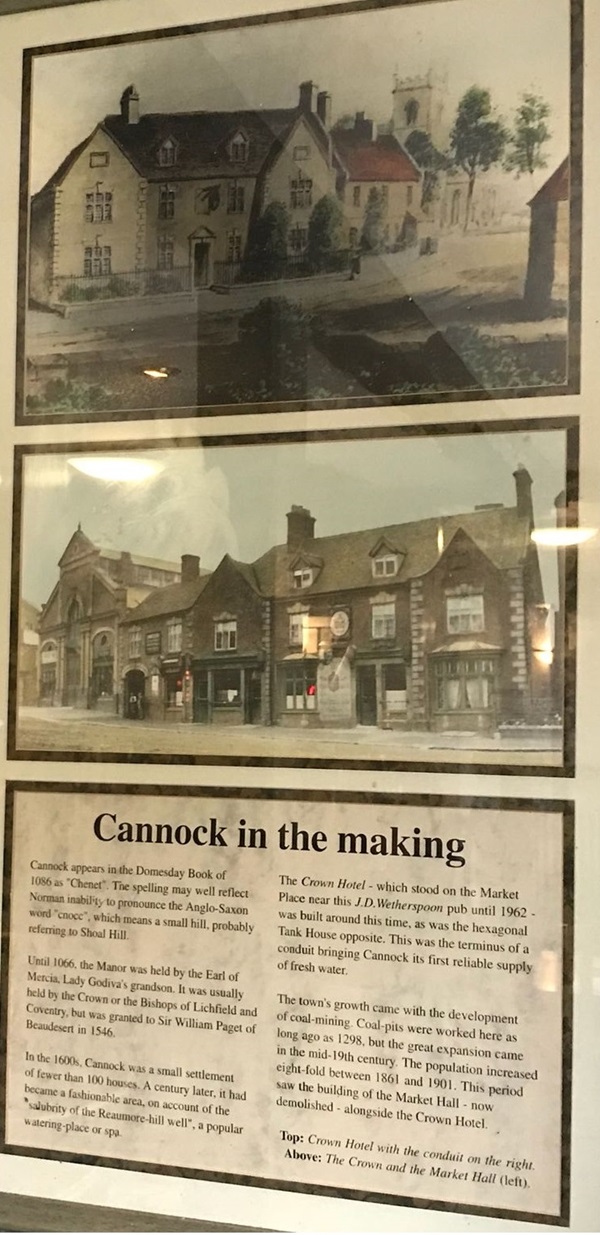
The text reads: Cannock appears in the Domesday Book of 1086 as “Chenet”. The spelling may well reflect Norman inability to pronounce the Anglo-Saxon word “once”, which means a small hill, probably referring to Shoal Hill.
Until 1066, the Manor was held by the Early of Mercia, Lady Godiva’s grandson. It was usually held by the Crown or the Bishops of Lichfield and Coventry, but was granted to Sir William Paget of Beaudesert in 1546.
In the 1600s, Cannock was a small settlement of fewer than 100 houses. A century later, it had become a fashionable area, on account of the “salubrity of the Reaumore-hill well”, a popular water-place or spa.
The Crown Hotel – which stood on the Market Place near this J D Wetherspoon pub until 1962 – was built around this time, as was the hexagonal Tank House opposite. This was the terminus of a conduit bringing Cannock its first reliable supply of fresh water.
The town’s growth came with the development of coal-mining. Coal-pits were worked here as long ago as 1298, but the great expansion came in the mid-19th century. The population increased eight-fold between 1861 and 1901. This period saw the building of the Market Hall – now demolished – alongside the Crown Hotel.
Top: Crown Hotel with the conduit on the right
Above: The Crown and the Market Hall (left).
Prints and text about Teddesley Hall.
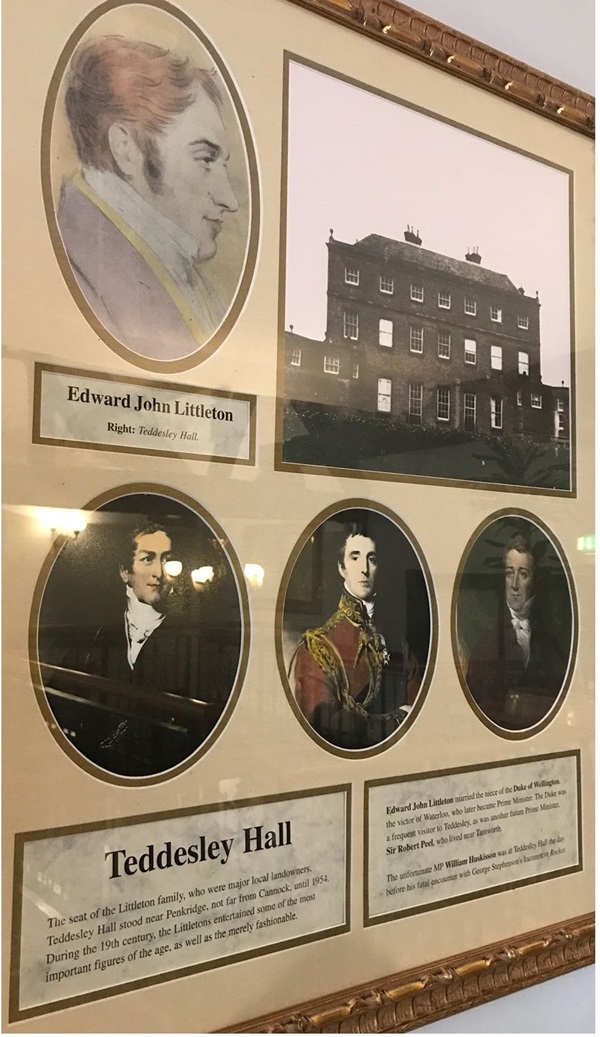
The text reads: The seat of the Littleton family, who were major local landowners. Teddesley Hall stood near Penkridge, not far from Cannock, until 1954. During the 19th century, the Littleton’s entertained some of the most important figures of the age, as well as the merely fashionable.
Edward John Littleton married the niece of the Duke of Wellington, the victor of Waterloo, who later became Prime Minister. The Duke was a frequent visitor to Teddesley, as was another future Prime Minister, Sir Robert Peel, who lived near Tamworth.
The unfortunate MP William Huskisson was at Teddesley Hall the day before his fatal encounter with George Stephenson’s locomotive Rocket.
Edward John Littleton – Right: Teddesley Hall
Photographs and text about Cannock Bowling Green Club.
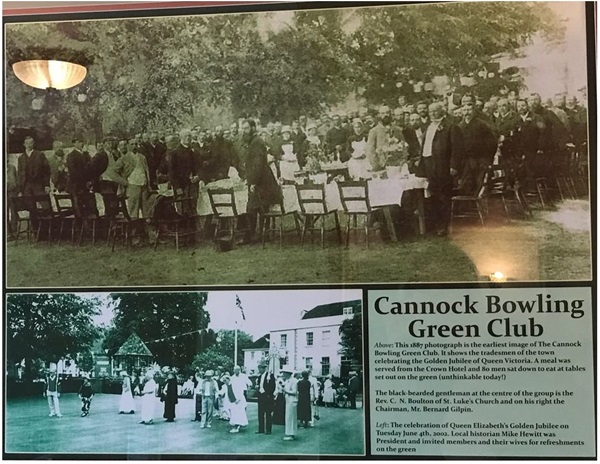
Above: This 1887 photograph is the earliest image of The Cannock Bowling Green Club. It shows the tradesmen of the town celebrating the Golden Jubilee of Queen Victoria. A meal was served from the Crown Hotel and 80 men sat down to eat at stables set out on the green (unthinkable today!)
The black-bearded gentleman at the centre of the group is the Rev CN Boulton of St Luke’s Church and on his right the Chairman, Mr Bernard Gilpin.
Left: The celebration of Queen Elizabeth’s Golden Jubilee on Tuesday June 4th, 2002. Local historian Mike Hewitt was president and invited members and their wives for refreshments on the green.
A print and text about the Vicar of Cannock.
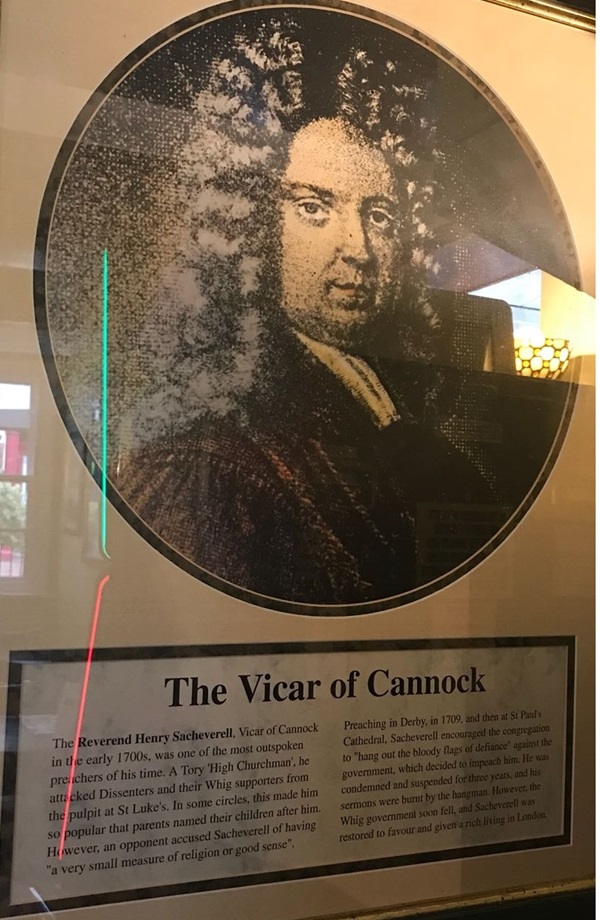
The text reads: The Reverend Henry Sacheverell, Vicar of Cannock in the early 1700s, was one of the most outspoken preachers of his time. A Tory ‘High Churchman’, he attacked Dissenters and their Whig supporters from the pulpit at St Luke’s. In some circles, this made him so popular that parents named their children after him. However, an opponent accused Sacheverell of having “a very small measure of religion or good sense.”
Preaching in Derby, in 1709, and then at St Paul’s Cathedral, Sacheverell encouraged the congregation to “hang out the bloody flags of defiance” against the government, which decided to impeach him. He was condemned and suspended for three years, and his sermons were burnt by the hangman. However, the Whig government soon fell, and Sacheverell restored to favour and given a rich living in London.
A print and text about Charles II.
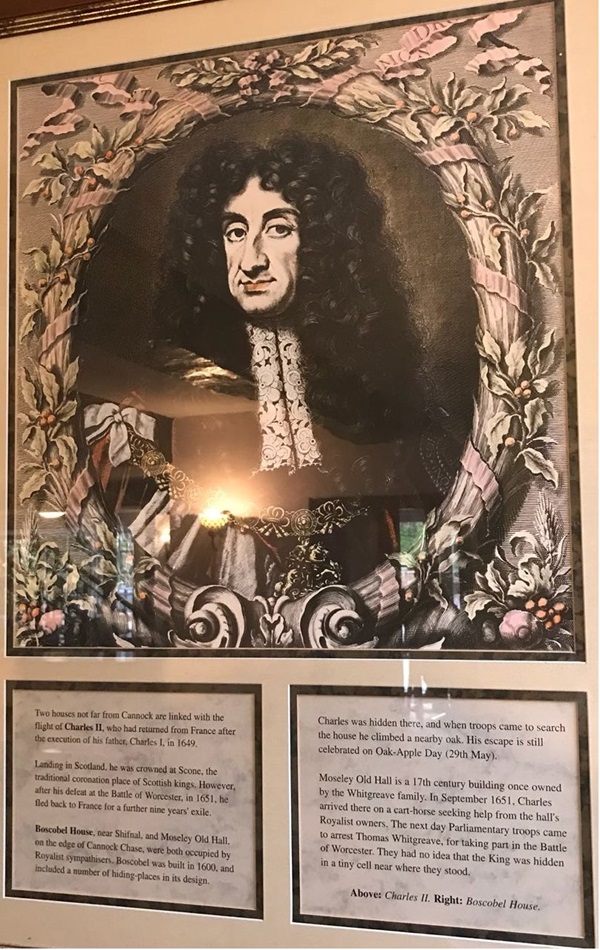
The text reads: Two houses not far from Cannock are linked with the flight of Charles II, who had returned from France after the execution of his father, Charles I, in 1649.
Landing in Scotland, he was crowned at Scone, the traditional coronation place of Scottish kings. However, after his defeat at the Battle of Worcester, in 1651, he fled back to France for a further nine years’ exile.
Boscobel House, near Shifnal, and Moseley Old Hall, on the edge of Cannock Chase, were both occupied by Royalist sympathisers, Boscobel was built in 1600, and included a number of hiding places in its design.
Charles was hidden there, and when troops came to search the house he climbed a nearby oak. His escape is still celebrated on Oak-Apple Day (29 May).
Moseley Old Hall is a 17th century building once owned by the Whitgreave family. In September 1651, Charles arrived there on a cart-horse seeking help from the hall’s Royalist owners. The next day Parliamentary troops came to arrest Thomas Whitgreave, for taking part in the Battle of Worcester. They had no idea that the King was hidden in a tiny cell near where they stood.
Above: Charles II
Right: Boscobel House.
Photographs and text about coal-mining in the area.
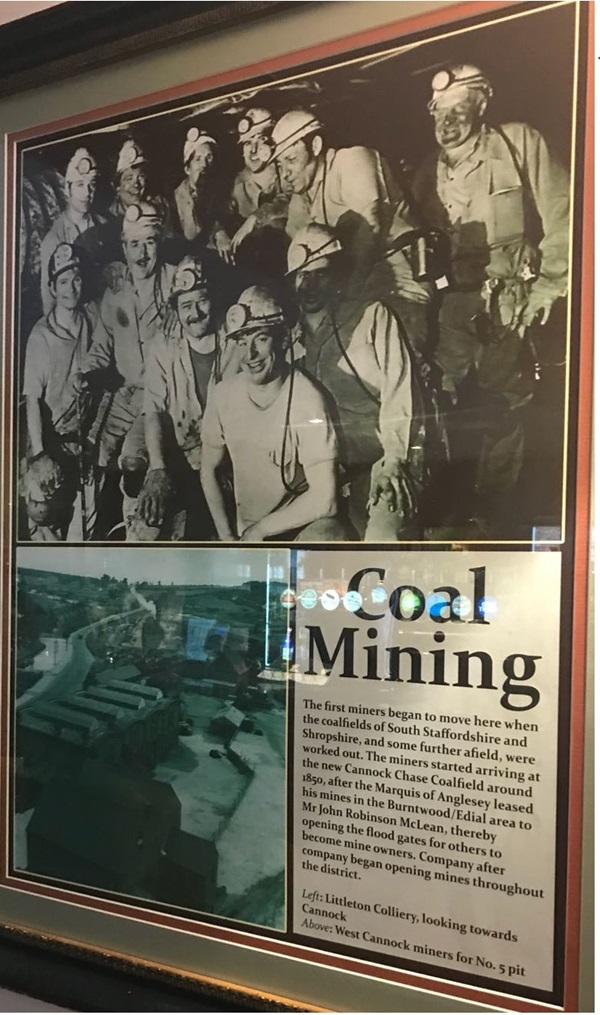
The text reads: The first miners began to move here when the coalfields of South Staffordshire and Shropshire, and some further afield, were worked out. The miners started arriving at the new Cannock Chase Coalfield around 1850, after the Marquis of Anglesey leased his mines in the Burntwood/Edial area to Mr John Robinson McLearn, thereby opening the flood gates for others to become mine owners. Company after company began opening mines throughout the district.
Left: Littleton Colliery, looking towards Cannock
Above: West Cannock miners for No.5 pit.
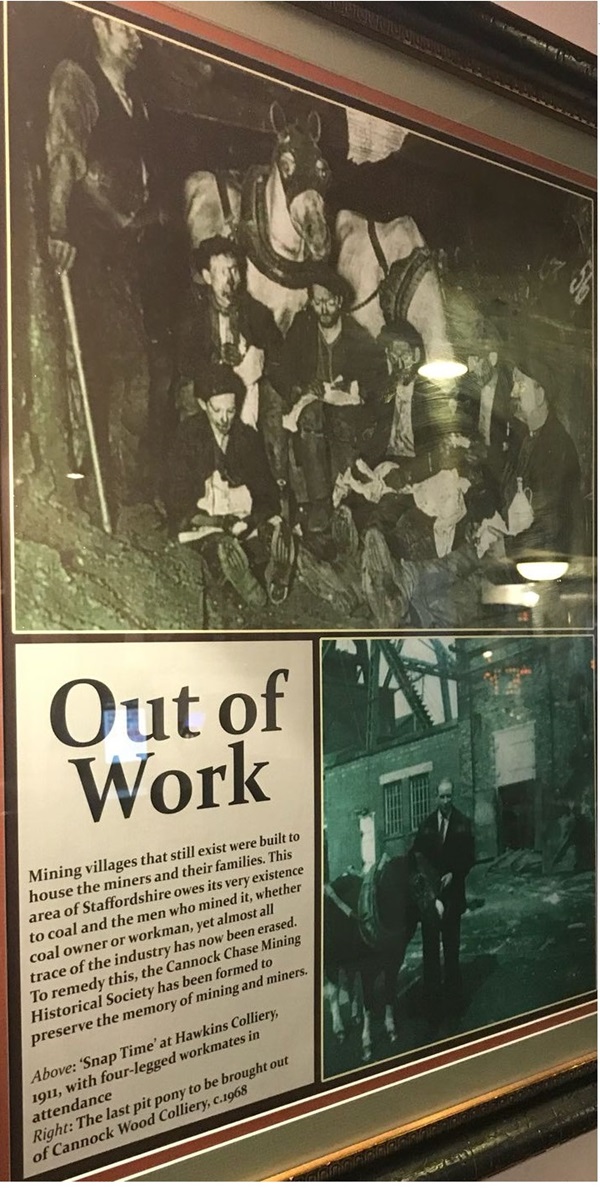
The text reads: Mining villages that still exist were built to house the miners and their families. This area of Staffordshire owes its very existence to coal and the men who mined it, whether coal owner or workman, yet almost all trace of the industry has now been erased. To remedy this, the Cannock Chase Mining Historical Society has been formed to preserve the memory of mining and miners.
Above: ‘Snap Time’ at Hawkins Colliery, 1911 with four-legged workmates in attendance
Right: The last pit pony to be brought out of Cannock Wood Colliery, c1968.
A drawing of The Crown Hotel.
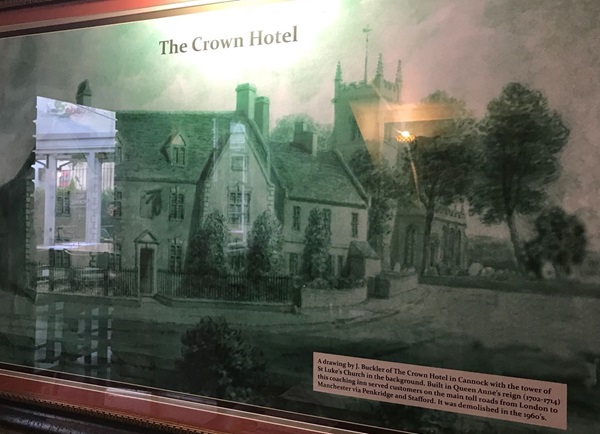
A drawing by J Buckler of The Crown Hotel in Cannock with the tower of St Luke’s Church in the background. Built in Queen Anne’s reign (1702-14) this coaching inn served customers on the main toll roads from London to Manchester via Penkridge and Stafford. It was demolished in the 1960s.
An early photograph of The Crown Inn, c1890.
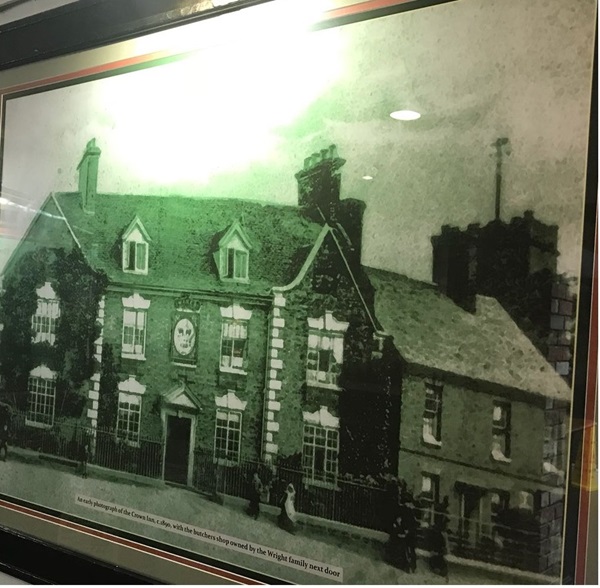
With the butcher’s shop owned by the Wright family next door.
Photographs of Cannock Town Football Club.
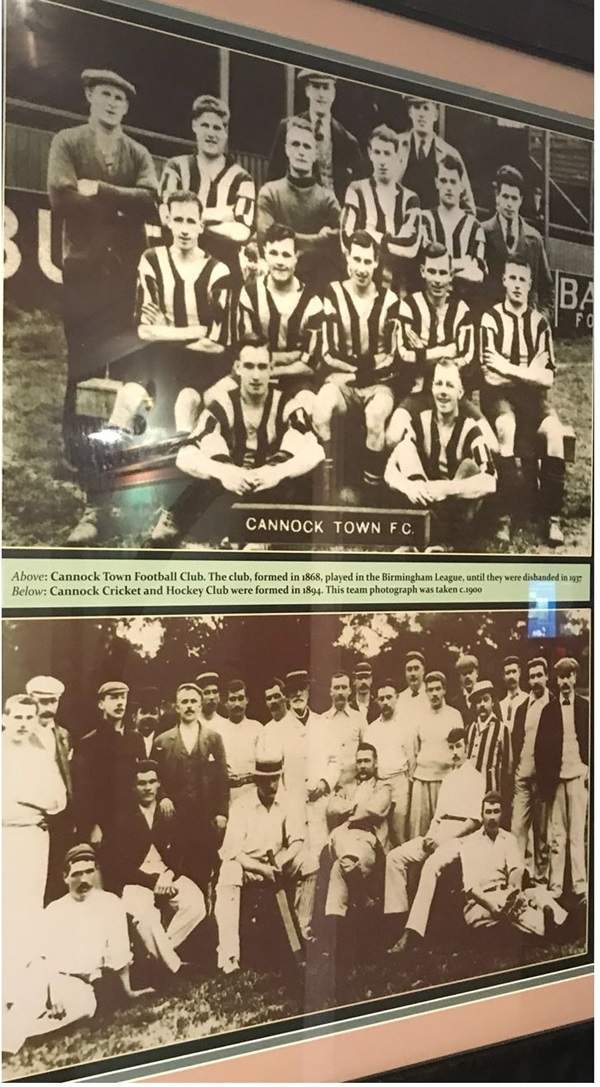
Above: Cannock Town Football Club. The club, formed in 1868, played in the Birmingham League, until they were disbanded in 1937.
Below: Cannock Cricket and Hockey Club were formed in 1894. This team photograph was taken, c1900.
A photograph of Linford’s shop, c1912.
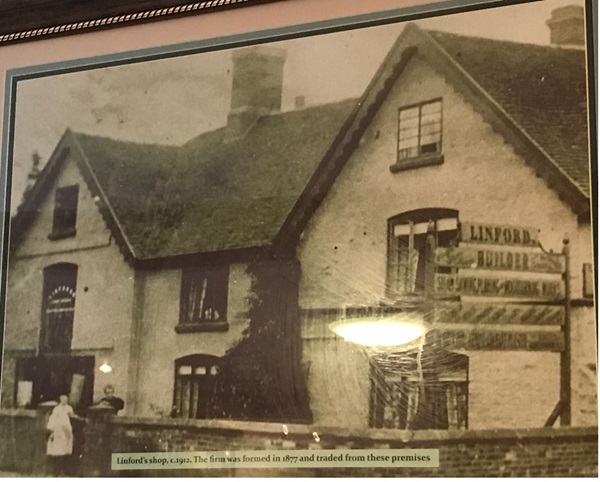
The firm was formed in 1877, and traded from these premises
Text about the new extension on this building.
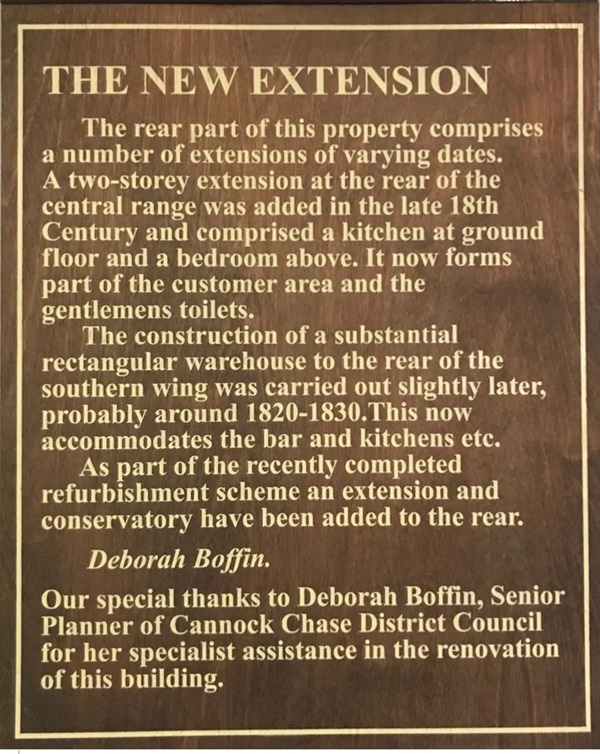
The text reads: The rear part of this property comprises a number of extensions of varying dates. A two-storey extension at the rear of the central range was added in the late 18th century and comprised a kitchen at ground floor and a bedroom above. It now forms part of the customer area and the gentlemen’s toilets.
The construction of a substantial rectangular warehouse to the rear of the southern wing was carried out slightly later, probably around 1820-30. This now accommodates the bar and kitchens etc.
As part of the recently completed refurbishment scheme an extension and conservatory have been added to the rear.
Deborah Boffin.
Our special thanks to Debrah Boffin, Senior Planner of Cannock Chase District Council for her specialist assistance in the renovation of this building.
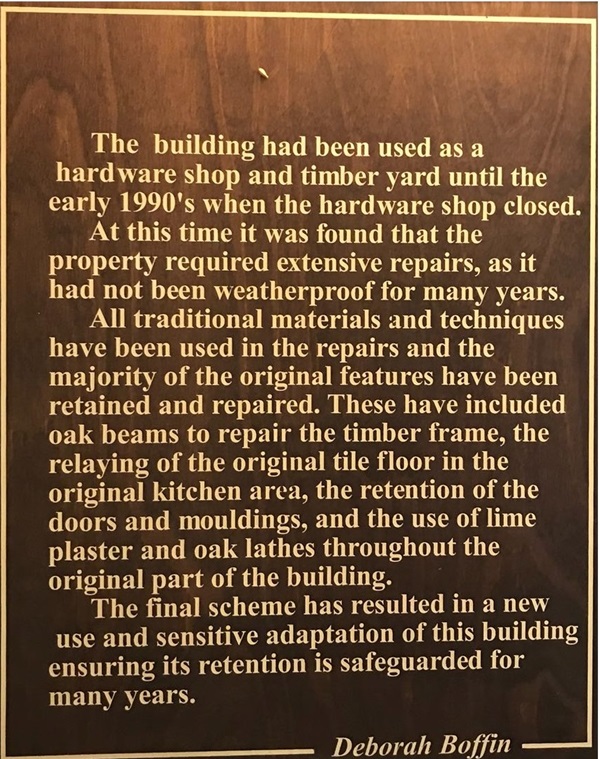
The text reads: The building had been used as a hardware shop and timber yard until the early 1900s when the hardware shop closed.
At this time it was found that the property required extensive repairs, as it had not been weatherproof for many years.
All traditional materials and techniques have been used in the repairs and the majority in the original features have been retained and repaired. These have included oak beams to repair the timber frame, the relaying of the original tile floor in the original kitchen area, the retention of the doors and mouldings, and the use of lime plaster and oak lathes throughout the original part of the building.
The final scheme has resulted in a new use and sensitive adaptation of this building ensuring its retention is safeguarded for many years.
External photograph of the building – main entrance.
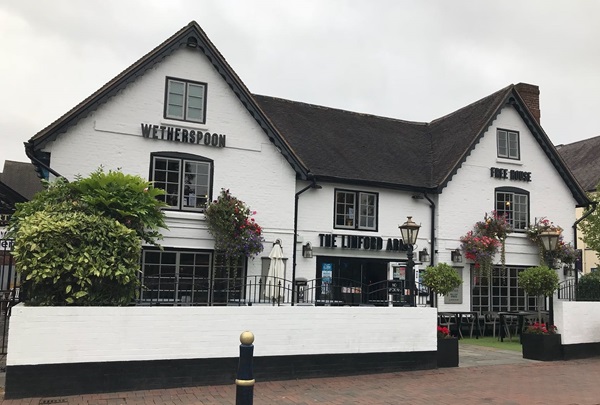
If you have information on the history of this pub, then we’d like you to share it with us. Please e-mail all information to: pubhistories@jdwetherspoon.co.uk